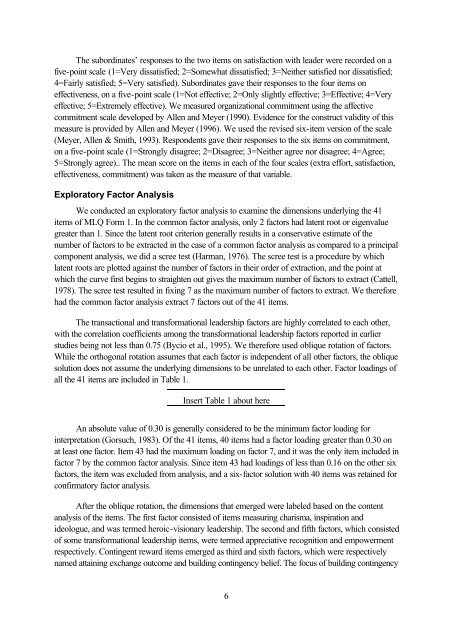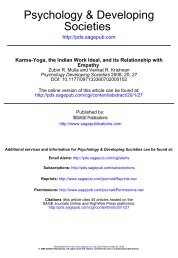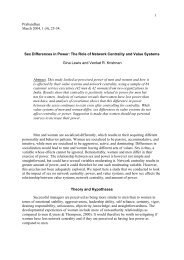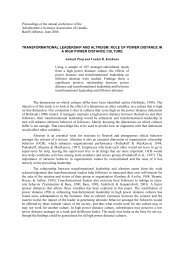Transactional and Transformational Leadership - Venkat R ...
Transactional and Transformational Leadership - Venkat R ...
Transactional and Transformational Leadership - Venkat R ...
You also want an ePaper? Increase the reach of your titles
YUMPU automatically turns print PDFs into web optimized ePapers that Google loves.
The subordinates’ responses to the two items on satisfaction with leader were recorded on afive-point scale (1=Very dissatisfied; 2=Somewhat dissatisfied; 3=Neither satisfied nor dissatisfied;4=Fairly satisfied; 5=Very satisfied). Subordinates gave their responses to the four items oneffectiveness, on a five-point scale (1=Not effective; 2=Only slightly effective; 3=Effective; 4=Veryeffective; 5=Extremely effective). We measured organizational commitment using the affectivecommitment scale developed by Allen <strong>and</strong> Meyer (1990). Evidence for the construct validity of thismeasure is provided by Allen <strong>and</strong> Meyer (1996). We used the revised six-item version of the scale(Meyer, Allen & Smith, 1993). Respondents gave their responses to the six items on commitment,on a five-point scale (1=Strongly disagree; 2=Disagree; 3=Neither agree nor disagree; 4=Agree;5=Strongly agree).. The mean score on the items in each of the four scales (extra effort, satisfaction,effectiveness, commitment) was taken as the measure of that variable.Exploratory Factor AnalysisWe conducted an exploratory factor analysis to examine the dimensions underlying the 41items of MLQ Form 1. In the common factor analysis, only 2 factors had latent root or eigenvaluegreater than 1. Since the latent root criterion generally results in a conservative estimate of thenumber of factors to be extracted in the case of a common factor analysis as compared to a principalcomponent analysis, we did a scree test (Harman, 1976). The scree test is a procedure by whichlatent roots are plotted against the number of factors in their order of extraction, <strong>and</strong> the point atwhich the curve first begins to straighten out gives the maximum number of factors to extract (Cattell,1978). The scree test resulted in fixing 7 as the maximum number of factors to extract. We thereforehad the common factor analysis extract 7 factors out of the 41 items.The transactional <strong>and</strong> transformational leadership factors are highly correlated to each other,with the correlation coefficients among the transformational leadership factors reported in earlierstudies being not less than 0.75 (Bycio et al., 1995). We therefore used oblique rotation of factors.While the orthogonal rotation assumes that each factor is independent of all other factors, the obliquesolution does not assume the underlying dimensions to be unrelated to each other. Factor loadings ofall the 41 items are included in Table 1.Insert Table 1 about hereAn absolute value of 0.30 is generally considered to be the minimum factor loading forinterpretation (Gorsuch, 1983). Of the 41 items, 40 items had a factor loading greater than 0.30 onat least one factor. Item 43 had the maximum loading on factor 7, <strong>and</strong> it was the only item included infactor 7 by the common factor analysis. Since item 43 had loadings of less than 0.16 on the other sixfactors, the item was excluded from analysis, <strong>and</strong> a six-factor solution with 40 items was retained forconfirmatory factor analysis.After the oblique rotation, the dimensions that emerged were labeled based on the contentanalysis of the items. The first factor consisted of items measuring charisma, inspiration <strong>and</strong>ideologue, <strong>and</strong> was termed heroic-visionary leadership. The second <strong>and</strong> fifth factors, which consistedof some transformational leadership items, were termed appreciative recognition <strong>and</strong> empowermentrespectively. Contingent reward items emerged as third <strong>and</strong> sixth factors, which were respectivelynamed attaining exchange outcome <strong>and</strong> building contingency belief. The focus of building contingency6





